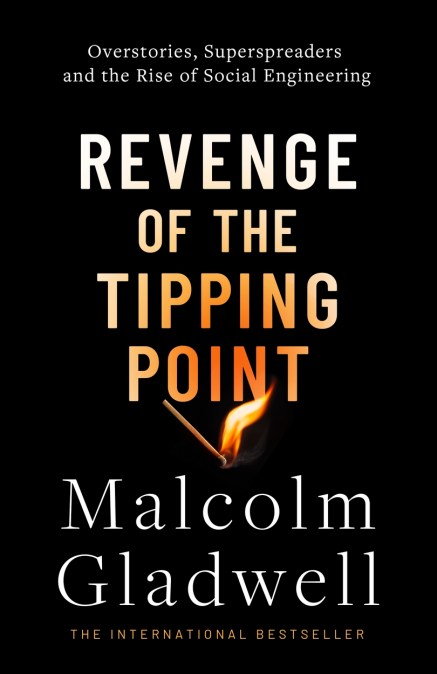Twenty-five years after the publication of his groundbreaking first book, Malcolm Gladwell returns with a brand new volume that reframes the lessons of The Tipping Point in a startling and revealing light
‘Addictive… fascinating and provocative’ Guardian
‘Malcolm Gladwell explores the watershed moments that define this new age of societal upheaval… with curiosity and humor’ TIME Magazine
‘Gladwell is a great storyteller with a contagious sense of curiosity’ The Economist
‘The match that so elegantly graced the cover of The Tipping Point is now on fire’ Wall Street Journal
Why in the late 1980s and early ’90s did Los Angeles become the bank robbery capital of the world? What is the magic third and what does it have to do with racial equity? What do big cats and clusters of teen suicide have in common? These are just some of the questions Malcolm Gladwell addresses in this new work, which revisits the phenomenon of epidemics and examines the ways in which we have learned to tinker with and manipulate the spread of ideas, viruses, and trends-sometimes with great success, sometimes with disastrous consequences.
Gladwell shows that – whether in neighbourhoods, schools, zoos, or conference rooms-today’s epidemics are no longer singular occurrences, but turbocharged versions of their earlier counterparts. Tipping points, he explains, play a much bigger role in our lives now than ever before. With this provocative and fascinating new book, we can meet them in novel and innovative ways.
‘Addictive… fascinating and provocative’ Guardian
‘Malcolm Gladwell explores the watershed moments that define this new age of societal upheaval… with curiosity and humor’ TIME Magazine
‘Gladwell is a great storyteller with a contagious sense of curiosity’ The Economist
‘The match that so elegantly graced the cover of The Tipping Point is now on fire’ Wall Street Journal
Why in the late 1980s and early ’90s did Los Angeles become the bank robbery capital of the world? What is the magic third and what does it have to do with racial equity? What do big cats and clusters of teen suicide have in common? These are just some of the questions Malcolm Gladwell addresses in this new work, which revisits the phenomenon of epidemics and examines the ways in which we have learned to tinker with and manipulate the spread of ideas, viruses, and trends-sometimes with great success, sometimes with disastrous consequences.
Gladwell shows that – whether in neighbourhoods, schools, zoos, or conference rooms-today’s epidemics are no longer singular occurrences, but turbocharged versions of their earlier counterparts. Tipping points, he explains, play a much bigger role in our lives now than ever before. With this provocative and fascinating new book, we can meet them in novel and innovative ways.
Newsletter Signup
By clicking ‘Sign Up,’ I acknowledge that I have read and agree to Hachette Book Group’s Privacy Policy and Terms of Use
Reviews
In Revenge of the Tipping Point, splashy theories abound, as they do in Gladwell's podcast, Revisionist History... He turns the conceit [of The Tipping Point]on its head, examining the forces that drive negative epidemics, which to him felt more attuned to our present moment
The long-awaited follow-up to The Tipping Point, Malcolm Gladwell's groundbreaking 2000 debut, explores the watershed moments that define this new age of societal upheaval...with curiosity and humor
To his adept synthesis of academic research he adds journalistic curiosity, a crisp prose style and a mastery of counter-intuitive juxtapositions. Often beginning with a conundrum, he seeks out case studies and concepts that illuminate it, altering (slightly or radically) our understanding of the world
Gladwell is a great storyteller with a contagious sense of curiosity
Refining and deepening his and our understanding of the spread of customs, mores, and practices, Gladwell emphasizes those overstories, illustrating them with twisting and turning tales of, for example, how the word holocaust came into general usage (surprisingly, via TV), how the idea of gay marriage gained acceptability, and how widespread social engineering has quietly become one of the central activities of the American establishment. Fans of the original will learn much from Gladwell's thoughtful, carefully written reconsideration
Positioning his theory of the superspreader within COVID-19 and the opioid epidemic, Gladwell deftly demonstrates how attention to statistics and data points can shape a business, school, or community. An astute and bracing appraisal of how cultures succeed or fail. Best-selling Gladwell's updating of the concepts in the book that made him famous will garner lively media coverage and reader interest
Brimming with fun and insightful anecdotes... Revenge of the Tipping Point will leave you pondering Gladwell's theories and asking more questions...The book explores how individuals can use power and influence to shape...the collective narratives we tell ourselves as groups or as a society - and in so doing steward policies and perspectives
Addictive... fascinating and provocative
Gladwell gives us a sort of interactive nonfiction, not unlike a detective story... Revenge of the Tipping Point essentially asks why we were all so ready to think anything that spreads like a virus could be good for us. In the first book we had connectors, mavens and salesmen. Now we have overstories, superspreaders and social engineering... The match that so elegantly graced the cover of The Tipping Point is now on fire
Full of interesting facts... Gladwell digs up some great material
Rigorously researched-but always with a witty flair-it's a must-read for longtime Gladwell fans or readers simply curious about the quiet, surprising origin stories of the crises and questions that define contemporary life


